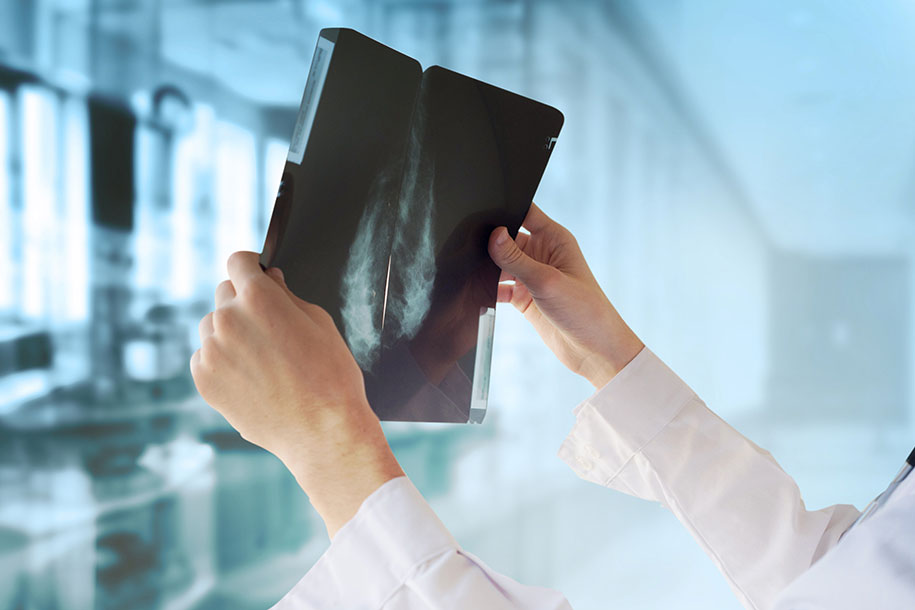Occasional throbbing pain in the breast, beware of breast cancer
Breast cancer is a pathological condition in which mammary gland cells grow uncontrollably, creating malignant tumors, which have the ability to divide strongly, invade surrounding areas, and metastasize to distant sites.
In general, the incidence of breast cancer tends to increase in recent years. Although breast cancer rates are increasing, now, worldwide, breast cancer survival rates have increased, thanks to early diagnosis, new treatment methods and better knowledge of the disease. More and more patients are undergoing breast-conserving treatment or breast reconstruction after mastectomy to restore the shape of the mammary gland, the pride of femininity.

Cancer cells can metastasize to other parts of the body
Symptoms and diagnosis of breast cancer
Breast cancer is a disease with a long course of disease, so there is a period of time even though the tumor has formed, there may be no symptoms. Therefore, women need to self-examine their breasts regularly, to detect abnormalities in time when there are small changes.
Common symptoms in breast cancer patients include:
The patient has a feeling of pain in the breast, which can be an infrequent, sharp pain in the form of a pins and needles. Some patients present with nipple discharge, which may be bloody.
In the late stages, symptoms can be seen due to invasive breast tumors causing ulcers, necrosis outside the skin, causing discharge, and a stench.
Symptoms of the tumor have spread to other organs in the body such as: bone metastasis cause bone pain, brain metastases causing headache, nausea, dizziness… In addition, patients may have systemic symptoms such as fatigue, anorexia, poor appetite, thin weight loss, sometimes manifest fever.
Regarding the diagnosis of breast cancer, there are now many cases of patients who have regular check-ups with doctors to detect breast cancer through screening with mammograms, through periodic health checks, usually after ultrasound.
Breast MRI Indicated for some special disease situations when mammography suspects occult breast cancer, multiple masses (lumps), axillary lymph node metastases of unknown origin.
PET and PET/CT scan Indicated when other imaging modalities are unrecognizable in metastatic breast cancer, PET may aid in the assessment of disease spread and may help modify management in some patients.
Biopsy Also used to confirm breast cancer.

Many patients have regular check-ups with doctors to detect breast cancer through screening with mammograms
Breast cancer treatments
The doctor considers the patient’s situation and combines several methods based on factors such as: what type of breast cancer is, how big is the tumor, at what stage, whether the cancer cells have a high or low grade, and who whether the patient has been in menopause, the status of the specific ER, PR, HER2 receptors and the patient’s general health.
– Breast cancer surgery
Depending on the patient, the doctor prescribes appropriate. Breast cancer treatments include:
Breast-conserving therapy: The doctor cuts the tumor wide (remove the tumor and a safe border of surrounding healthy tissue) combined with postoperative radiation therapy applied to small tumors. Modified radical mastectomy (Patey surgery): mastectomy to remove the entire mammary gland, scrape many axillary nodes in the same breast.
– Instant breast reconstruction: Immediately after the mastectomy, the patient was reconstructed the breast shape with autologous tissue (back muscle flap, rectus muscle flap, buttock flap, thigh) or with implant (saline or silicone bag.
– Radiotherapy
Radiation therapy is the use of high-energy beams to kill cancer cells. Often used is external radiation therapy, a machine that delivers a beam of light precisely to the breast. Radiation therapy is always used after breast-conserving surgery for early breast cancer. After mammography performed for large tumors or metastatic lymph nodes.
– Valence
Chemotherapy is the use of drugs that kill cancer cells. After surgery, if there is a risk of recurrence or metastasis, doctors use chemotherapy called adjuvant chemotherapy. Chemotherapy is also used to treat people whose cancer has spread in the body. Side effects of chemotherapy include hair loss, vomiting, fatigue, and susceptibility to infection. Less common: early menopause, damage to the heart, kidneys and peripheral nerves.
– Biological therapy (targeted)
In fact, the treatment of breast cancer requires a multimodal combination of methods: surgery, chemotherapy, radiation therapy, biological drugs, immunotherapy, targeting and endocrine therapy. But biologic therapy, or multi-targeting, is still a novelty.
In addition to surgery, chemotherapy and radiation, breast cancer can also be treated with targeted therapy. Targeted therapy in the treatment of breast cancer is the use of drugs that limit the growth and spread of tumors, often applied in patients with advanced, advanced and distant breast cancer. that local treatments such as surgery and radiotherapy cannot do.
Unlike chemotherapy drugs, targeted therapy uses drugs to kill cancer cells and do almost no harm to other healthy cells. Undesirable effects of targeted drugs include: small bleeding under the skin, rash, rash… these are common effects, but currently targeted drugs are one of the best treatment measures. In many cases, breast cancer is advanced, late stage.
In addition, doctors also use endocrine therapies that are also effective for cancer patients in general, breast cancer in particular.
Breast cancer occurs when some breast cells begin to grow abnormally, these cells multiply faster than healthy cells and clump into tumors. Cancer usually arises from the cells of the milk ducts (called ductal cancer 80%), also from glandular tissue called lobules (lobular cancer – 10%) or from other types of cells. Other cells in the breast are rarer. Cancer cells can spread to the axillary lymph nodes and metastasize to other places in the body.
5. Breast cancer prevention
Women, please “listen” to your body, understand your breasts, when there are abnormal signs, you should immediately go to a specialist treatment facility.
For patients with breast cancer, after treatment, the patient needs to be periodically monitored so that the doctor can examine and do appropriate tests.
Depending on the stage of the disease and the method of treatment, it is necessary to detect and manage cases of recurrence, side effects and sequelae of treatment, as well as guide nutrition and improve the quality of life for patients. Doctors usually recommend yearly mammograms and follow-up visits every 3-6 months for the first 3 years, 6-12 months for the next 2 years, and 12 months for the following years.
Patients should absolutely not treat according to the advice, avoid some incorrect treatment methods such as applying pus-extraction, taking leprosy, washing leaves or injecting to make the disease flare up, only temporary treatment remains and the outcome is very bad. .
Specialist doctors combine surgery – radiation – chemotherapy and biological therapy very smoothly to suit each patient, helping patients with early breast cancer many people recover from disease, late stage breast cancer and cancer patients. prevalence prolongs survival and improves quality of life.
at Blogtuan.info – Source: Afamily.vn – Read the original article here



